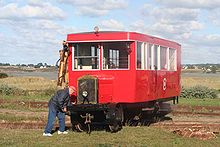Georges Tartary
Georges Tartary ( 1867 - 1938 ) was a French engineer and inventor . The specialist in rail traffic on secondary lines is considered one of the "fathers" of the rail bus .
history
Tartary was manager of the railway company Compagnie des Tramways des Deux-Sevres (TDS), a member of the Board of several French branch lines as the Tramways de l'Indre (TI), the Chemins de fer de l'Aube départementaux and the Chemin de fer du Blanc Argent (BA), as well as consulting engineer at the Compagnie des chemins de fer du Sud de l'Aisne (CSA). He dealt with the problem of reducing the high operating costs of transport with passenger trains pulled by steam locomotives . After the First World War , in 1919 he acquired twenty former ambulance buses of the United States Army and had them converted into meter-gauge rail vehicles in the TDS depot in Parthenay . They received a new car body and a patented , self-tracking front axle developed by him . Initially with a curved track that was carried along, the elements of which were attached to its long sides, and later with a lifting and rotating device attached under the floor of the car, the one-way vehicle could also change direction outside of permanently installed turntables .
On November 26, 1921, Tartary successfully tested such a vehicle between Romorantin and Valençay on the BA route, where it traveled at the astonishing speed of 44 km / h. From 1922 Tartary rail buses were used on the CSA network, in 1923/24 three Ai vehicles were running there, possibly pulling a single-axle sidecar. Tartary vehicles were also used by other French railway companies:
- Tramways des Deux-Sèvres : A, Ai and B
- Tramways de l'Indre : Ai
- Tramways de la Corrèze : A.
- Tramways de l'Aube : A
- CFD de l'Aisne : A, Ai, B
- SE Réseau de l'Anjou : B (acquired used in 1939)
- Régie Déartemantale d'Aunis et Saintonge : Ai (acquired used in 1929)
Tartary was married to Jeanne Tartary (née Herbin; 1876-1965). With her he had the daughters Suzanne (1900–1990) and Madeleine (1903–1955).
vehicles
All Tartary railcars were two-axle one-way vehicles. With types A and Ai, the engines were housed outside the passenger compartment in front of the driver's cab, with type B they were already in the interior. The initially manufactured type A had 16 seats, the ten vehicles of the extended type Ai, for which single-axle sidecars were also built, 24 seats. Several A-type vehicles were later converted to type B (with a rectangular floor plan).
- Type A: 16 seats, wheel base 3.20 m
- Type Ai: 24 seats and 8 standing places; Length 7.75 m, wheelbase 4.25 m, width 1.80 m, height 2.62 m, empty weight 2.5 t, output 18 hp , speed 35–40 km / h, plus a single-axle, 0.7 t heavy sidecar. The driver sat, separated from the passenger compartment, on the right side of the vehicle, to the left of him two bench seats were installed. Passengers boarded via double-sided, single-leaf doors at the rear of the vehicle.
- Type B: rectangular car body, engine in the interior, suitable for sidecar operation
In 1934, some of the railcars at the Tirbois in Niort and Heuliez in Cerizay companies received new " streamlined " bodies similar to the buses of that time . In 1936, Tartary bought back type A railcar 4 from the Tramways de l'Aube and converted it into a windowless, air-conditioned cattle transport car for TDS . However, since the frightened animals gathered in the overhanging rear, the vehicle tended to derail due to the resulting imbalance . In 1939 it was sold to the SE Réseau de l'Anjou , but was only rarely used there.

De Dion-Bouton also built rail buses from around 1923, using Tartary's patent for the lifting / rotating device under the car floor. The company SCF Verney was also directly inspired by Tartary's work. Both companies successfully gained a foothold in railcar construction, while Tartary did not allow any further vehicles to follow the type B.
Remarks
- ↑ The average speed on the route at that time was 18 km / h
Web links
- Le rapport de 1922 in: Correspondances ferroviares 9/2003
- Photos of A and Ai vehicles at train-jouet.com
- Photo of a type Ai with a sidecar , photo and drawings of a modernized ("streamline shape") type B, description and photo of the cattle transport vehicle
- Photo of a Type B with a sidecar in Archiac (Régie Déartemantale d'Aunis et Saintonge)
Individual evidence
- ↑ a b Documents qui montrent nos relations avec l'Argentine ... at freysselinard.pagesperso-orange.fr, accessed on July 27, 2019
- ^ A b c d e f W. JK Davies: The Light Railway Railcar in Western Europe . Plateway Press, East Harling 2004, ISBN 1-871980-52-6 , pp. 85 f .
- ↑ a b Château-Thierry et la Compagnie des Chemins de fer du Sud de l'Aisne at marc-andre-dubout.org, accessed on July 27, 2019
- ↑ a b c Le rapport de 1922 in: Correspondances ferroviares 9/2003, accessed on July 27, 2019
- ↑ Vincent Lepais, Michel Jacobs, Jean-Louis Audigué: Le chemin de fer du Blanc à Argent . Éditions LR Presse, Auray 2011, ISBN 978-2-903651-71-8 , p. 20 and 129 .
| personal data | |
|---|---|
| SURNAME | Tartary, Georges |
| BRIEF DESCRIPTION | French engineer and inventor (rail transport) |
| DATE OF BIRTH | 1867 |
| DATE OF DEATH | 1938 |